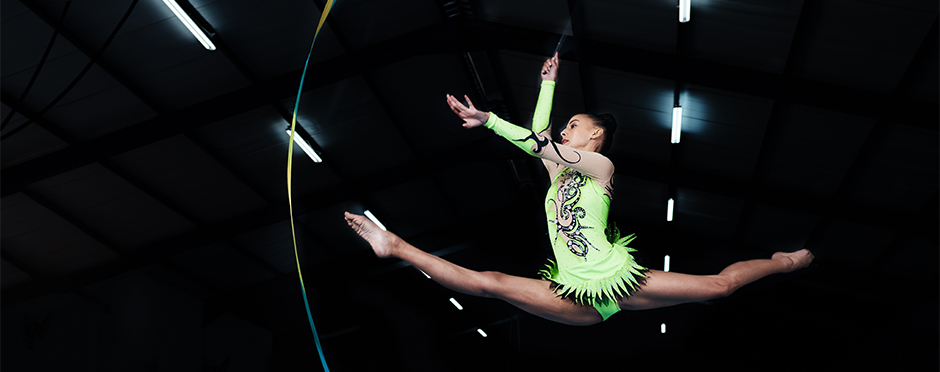
Foot Injuries in Rhythmic Gymnasts
Leave a CommentRhythmic gymnastics is a sport in which gymnasts perform on a floor with an apparatus: either a hoop, ball, rope, ribbon, or club. The sport combines dance and gymnastics and requires strong, flexible, coordinated athletes. Due to the nature of the sport and the repetition during practice and performing, the most common area of injury for rhythmic gymnasts is the foot.
Factors That Can Affect Risks for Foot Injuries
- Time spent training (hours per week)
- Training surface
- Flexibility
- Strength
- Jumping/landing mechanics
Types of Foot Injuries in Rhythmic Gymnasts
Stress Fractures
- Stress fractures in the foot are usually due to repetitive landings. Rhythmic gymnasts do not perform the tumbling passes commonly associated with artistic gymnastics, but they practice long hours and have a long competitive season, leading to many repetitions of their skills.
- Stress fractures usually present with pain localized over a certain area of the foot or ankle, possible swelling, pain with weight bearing, and increased pain with landings.
- Treatment includes rest from impact activities, and possibly the use of a walking boot or crutches. Physical therapy after a stress fracture will focus on strengthening and retraining in proper mechanics, especially for jumping and landing, as well as education on training volume.
Flexor Hallucis Longus (FHL) Tendinitis
- The FHL muscle and tendon run from the calf to the big toe along the inside portion of the ankle. This helps people stand on the tips of their toes. Rhythmic gymnasts constantly us this muscle to perform skills such as turns. FHL tendinitis is not common in the general population but is much more common in athletes such as dancers or gymnasts.
- Symptoms of FHL tendinitis include pain at the back of the ankle or under the foot near the big toe, pain that is worse when pushing off from the toes, swelling, a possible clicking sensation, and decreased range of motion.
- Treatment of FHL tendinitis includes rest, ice, compression, elevation, and physical therapy to help strengthen and retrain the tendon within the foot and ankle.
Achilles Tendinitis
- Achilles tendinitis is usually a strain at the insertion of the tendon into the heel bone or in the middle portion of the tendon. Rhythmic gymnasts are at increased risk of Achilles tendinitis due to the nature of their sport, which involves a lot of repetition of skills, sudden starts and stops, and repetitive jumping.
- Achilles tendinitis can present as swelling, tenderness, decreased ankle range of motion, painful relief, pain while walking uphill or climbing stairs, pain during exercise, and push-off.
- Treatment may include rest, ice, medication for inflammation as prescribed by your physician, physical therapy, and possible immobilization. It will also include stretching and strengthening the Achilles and surrounding muscles.
Ankle sprains
- A sprain is an injury to a ligament surrounding a joint, either an overstretch, twist or tear to a ligament.
- Symptoms of an ankle sprain include pain to the touch, swelling, pain when walking, bruising, difficulty moving the ankle through full range, and feeling unstable in the ankle.
- Treatment includes rest, ice, compression, and elevation. When returning to sport, athletes may use an ankle brace when returning to sport. Physical therapy can also help with recovery and minimizing the risk of recurrent ankle sprains.
Proper Landing Technique
- Land with a slight bend in the knees to avoid landing with knees locked straight
- Land on the toes and roll through the foot to a flat foot position to help absorb the impact of the landing
- Keep the stomach tight and the pelvis level to avoid arching in the lower back
- Keep your kneecap in line over the second toe and avoid letting the knees or feet fall into the middle
- Keep the chest upright
- Breathe; don’t hold your breath during skills
If you or your athlete are experiencing pain, do not wait. Schedule a free assessment at an Athletico near you.
Athletico provides rehabilitation to gymnasts of all levels and abilities. We have physical therapists involved with our Gymnastics and Cheerleading Program who understand the sport’s demands to address the athlete’s physical needs. Free assessments are available in-clinic and virtually through our telehealth platform.
*Per federal guidelines, beneficiaries of plans such as Medicare, Medicaid, Tricare, VHA and other federally funded plans are not eligible for free assessments.
The Athletico blog is an educational resource written by Athletico employees. Athletico bloggers are licensed professionals who abide by the code of ethics outlined by their respective professional associations. The content published in blog posts represents the opinion of the individual author based on their expertise and experience. The content provided in this blog is for informational purposes only, does not constitute medical advice and should not be relied on for making personal health decisions.
References:
1. Gulati R, Rychlik K, Wild JT, LaBella CR. Rhythmic gymnasts’ injuries in a pediatric sports medicine clinic in the United States: a 10-year retrospective chart review. Phys Sportsmed. 2022 Oct;50(5):454-460. doi: 10.1080/00913847.2022.2040890. Epub 2022 Feb 16. PMID: 35135415.
2. Zetaruk, M. N., Fors, M. V., Zurakowski, D., Mitchell Jr, W. A., & Micheli, L. J. (2006). Injuries and training recommendations in elite rhythmic gymnastics. Apunts: Medicina de l’esport, 100-106.
